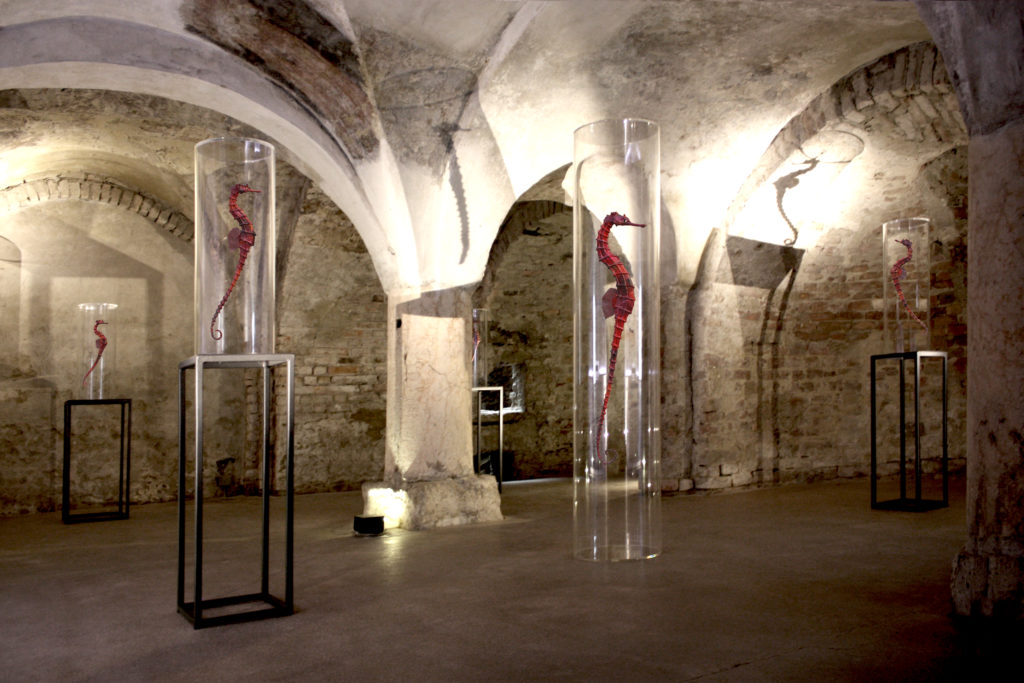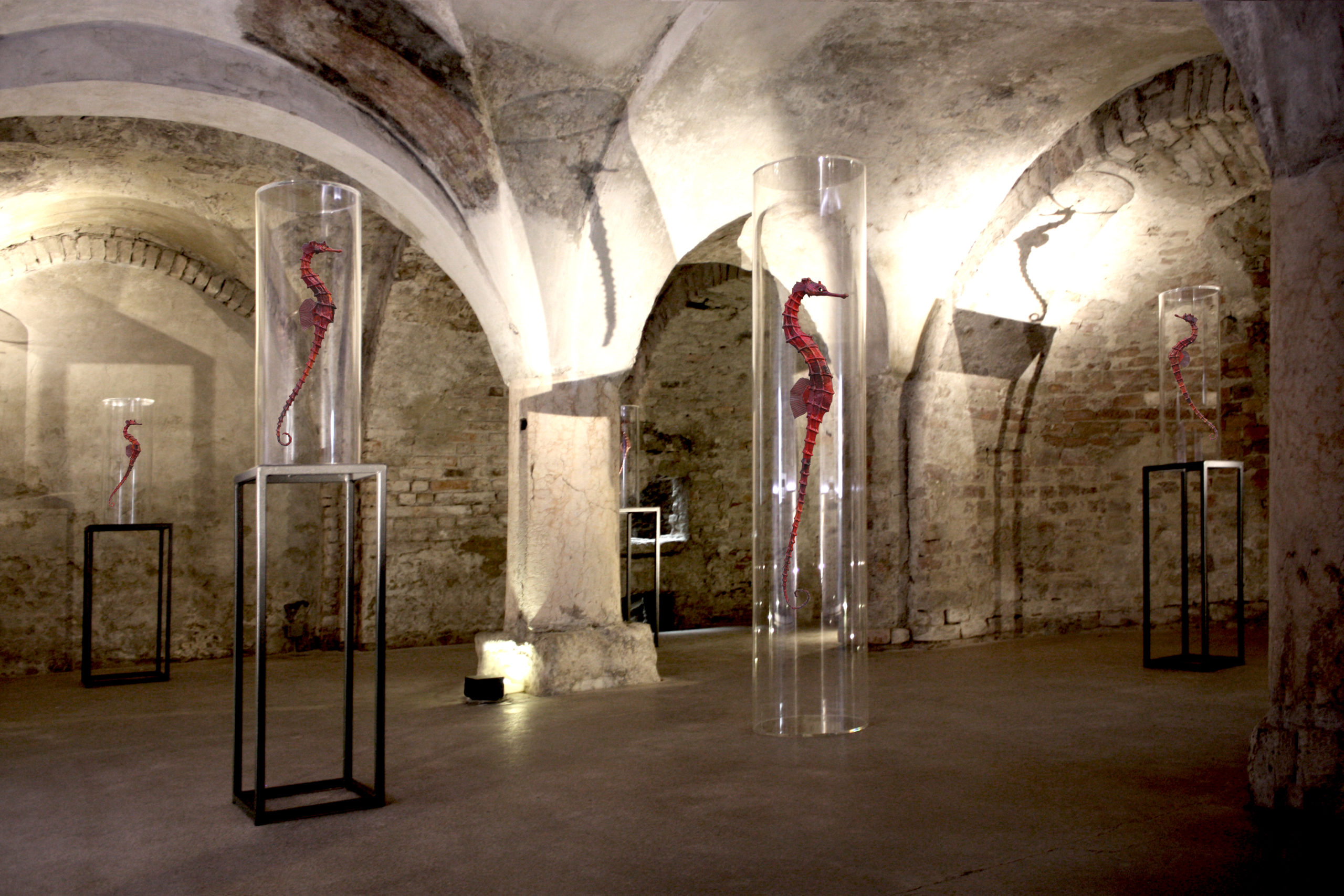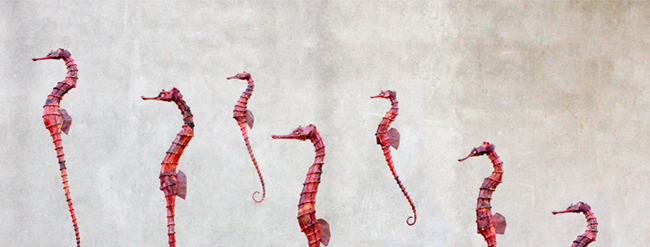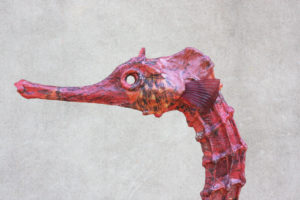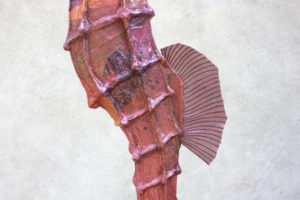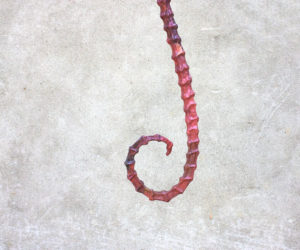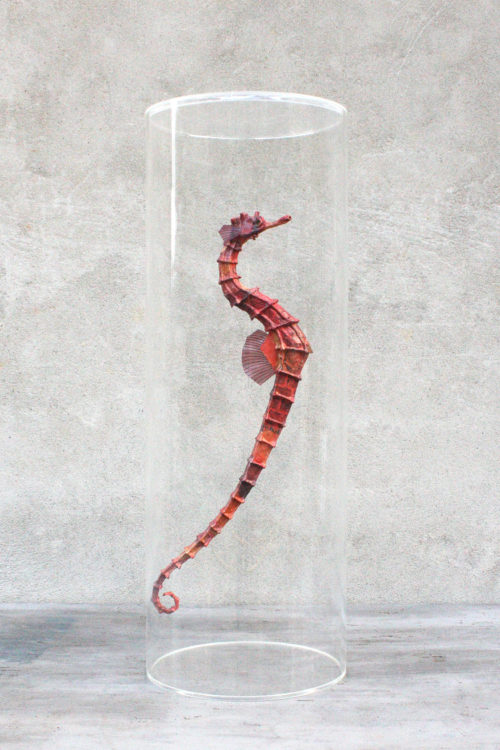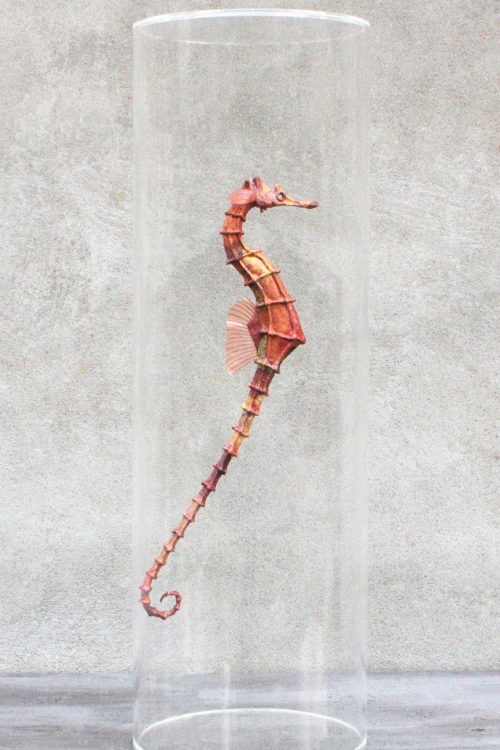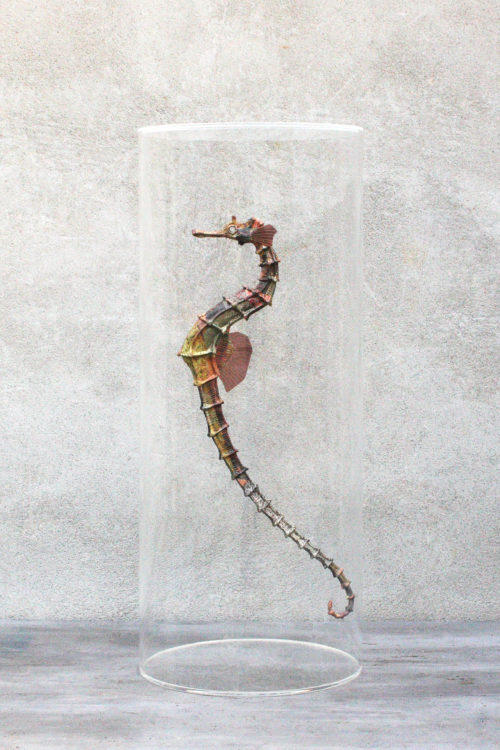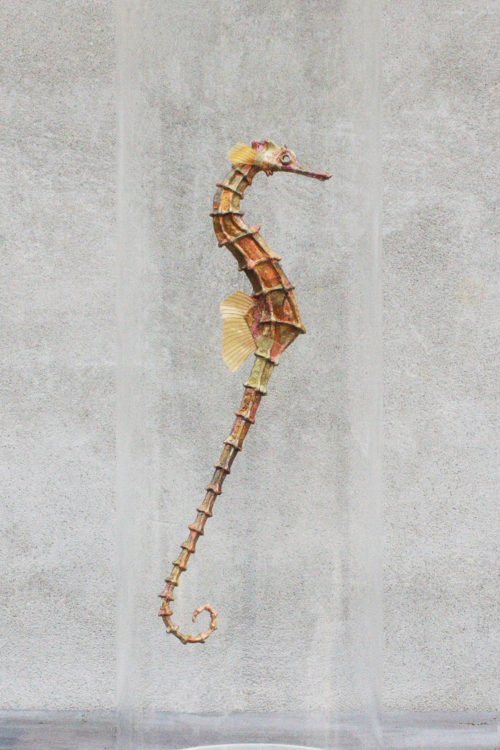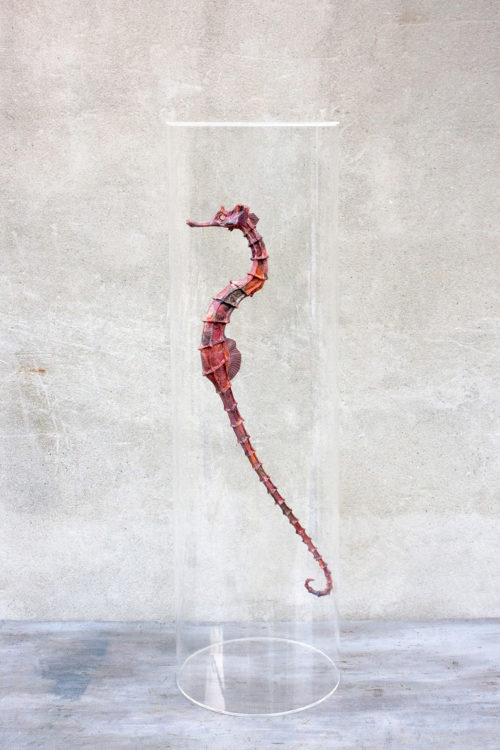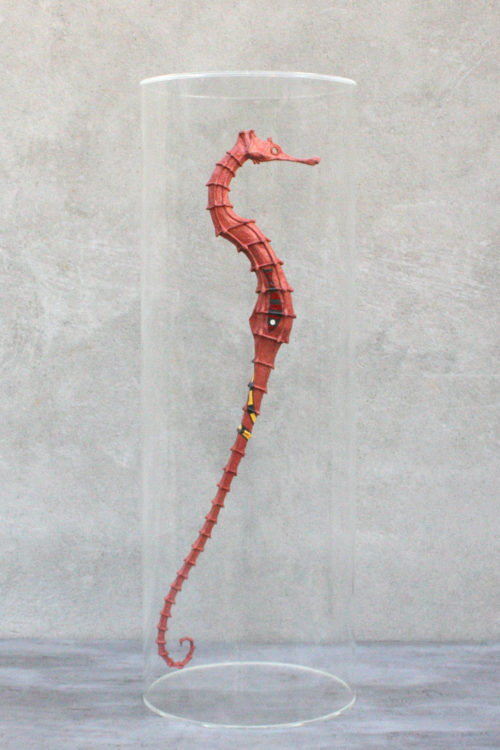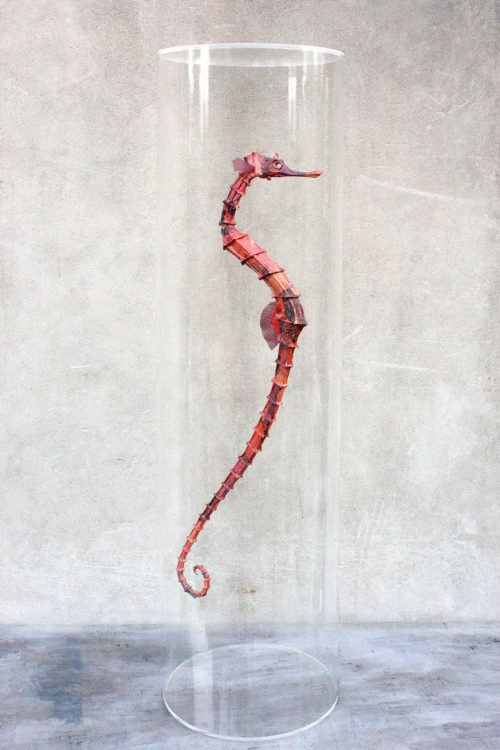The Great Hippocampus Question
di Jacqueline Ceresoli
Alice Zanin gioca con le forme mutevoli della natura e della fantasia, scolpisce entità immaginarie pseudo scientifiche, plasmando sculture di carta ispirate alle suggestioni delle sue letture di articoli scientifici, trattati di biologia, letteratura, mitologia e pubblicazioni del XIX secolo in bilico tra ilarità e ragione. L’installazione “The Great Hippocampus Question” ideata per la Società della Permanente a Milano, rientra in un progetto più ampio che prevede diverse tappe espositive con opere simboliche che ruotano intorno al tema dell’origine della specie teorizzata da Charles Darwin, del creazionismo di Sir Richard Owen e altri pensatori figli della cultura positivista incuriositi dalla presunta parentela tra il primate e l’uomo, dal mistero della creazione: tema discusso dell’epoca vittoriana. Le sue creature leggere come l’aria, filiformi come alghe, aleggiano nello spazio, sorprendono lo spettatore.
Si trovano volutamente là dove non te lo aspetti. Questi ippocampi misteriosi, emersi dalle acque “nuotano” sospesi nell’aria, sono apparizioni bizzarre che
si configurano come una continua allusione sul mistero della vita e l’origine acquatiche dell’uomo, senza mai configurarlo. Zanin dietro la sua ricognizione zoomorfica rielabora in chiave fantastica diverse specie animali, tutti dai colori improbabili, compilando un bestiario immaginario e simbolico come antidoto all’eccesso della ragione e insolito presupposto d’immersione nella selva oscura dell’inconscio per approfondire tematiche più complesse, dimensioni spirituali, misteriosofiche, contro l’eccesso ipertecnologico della nostra epoca digitale.
Incantano i suoi cavallucci di mare, di un rosso-aragosta, sottili come piante marine: esseri incantevoli che nel Duecento il cosmografo al Qazwini, nel suo trattato “Meraviglie del creato”, descrive come un inspiegabile incrocio tra la specie equina marina e quella di terra, soffermandosi sulla forma verticale allungata e arcuata, con la criniera e la coda più lunghe, rafforzata da una corona ossea e di colore lucente. Queste creature sono figlie del vento e dell’acqua insieme, su cui le ninfe, secondo la leggenda, cavalcano nella profondità dell’oceano. Le sculture fuori dall’acqua, introducono il concetto di “apparenza”: una concezione del mondo come menzogna, coscienza della parvenza teorizzata da Friedrich Nietzsche ne “La Gaia Scienza” (1887).
Gli ippocampi di Alice Zanin danzano nello spazio, sgravati dal peso della materia e “arrossiti” da uno strano pudore della consapevolezza di nascere innaturali, verosimiglianti come segni premonitori di altre dimensioni, immaginarie, evocative e persuasive, contro sguardi di realisti offuscati dalla ragione, dall’utopia del progresso e dall’impulso verso il reale, il vero, il certo, oltre le colonne d’Ercole in cui arte e scienza si contaminano e mettono in discussione teorie condivise con leggiadre forme del dubbio. Silhouette dell’effimero, codici di leggerezza, creature riferite a entità veloci di una zoologia fantastica. Da sotto a sopra, cambiano i punti di vista e i cavallucci dell’autrice vegliano su tutto ciò che è stato ed è al di là da venire, prelievi del sogno per spiriti liberi che prendono congedo dalla scienza.
Questi incantevoli emblemi dell’innaturalità emersi dall’inconscio di cose successe una volta negli abissi del mare, all’alba del mondo, fuori dal tempo,che piacerebbero al visionario e teosofo Rudolf Steiner. E tra cielo e mare, gli ippocampi di Alice Zanin sondano i fondali di ben altre profondità, escogitano forme di culto del falso sull’orizzonte tra menzogna e realtà
The Great Hippocampus Question
by Jacqueline Ceresoli
Alice Zanin plays with the shifting shapes of nature and fantasy. She sculpts pseudo-scientific imaginary entities, shaping paper sculptures inspired by the suggestions of her readings of scientific articles, biology treatises, literature, mythology, and nineteenth century publications, caught between cheerfulness and reason. The installation “The Great Hippocampus Question”, conceived for the Milan’s Società della Permanente, is part of a wider project that features several exhibitions, with symbolic works that revolve around the theme of the origin of the species theorized by Charles Darwin, of Sir Richard Owen’s creationism, and other positivist thinkers intrigued by the alleged relationship between primate and man, by the mystery of creation: a very debated topic in the Victorian era. Light as air, threadlike as seaweeds, hovering in space, her creatures amaze the viewer.
COLLECTION
They deliberately lie where we do not expect them. These mysterious hippocampi, emerged from the water, “swim” in the air. They are bizarre apparitions that are a continuous reference to the mystery of life and the aquatic origin of man, without ever giving a configuration to it. Zanin, behind her zoomorphic exploration, reworks, with an imaginary tone, various animal species. All with unlikely colours, they fill in an imaginary and symbolic bestiary as an antidote to the excess of reason and as an unusual requirement for the immersion in the dark wood of the unconscious, to examine in depth more complex issues, spiritual and mysteriosophical dimensions, against the hyper-technological excess of our digital age.
Her sea-horses, of a red-lobster, thin as sea plants, are enchanting: charming beings that, in the thirteenth century, the cosmographer al Qazwini, in his treatise “The Wonders of Creation,” describes as an inexplicable cross between the equine specie of the sea and that of the land, focusing on the elongated and arched vertical shape, with longer crest and tail, strengthened by a bony crown of a shiny colour. These creatures are children of the wind and water together, on which the nymphs, according to the legend, ride in the ocean depths. Out of the water, the sculptures introduce the concept of “appearance”: a conception of the world as a lie, the consciousness of appearance theorized by Friedrich Nietzsche in “The Gay Science” (1887).
Alice Zanin’s hippocampi dance in the space, relieved from the weight of the matter and “blushed” by a strange decency of the awareness of being born unnatural; verisimilar as warning signs of other dimensions, imaginary, evocative and persuasive, they stand against realists’ looks overshadowed by reason, by the utopia of progress, and by the impulse towards the real, the true, the certain, beyond the pillars of Hercules where art and science contaminate each other and call into question, with graceful forms of doubt, shared theories. Ephemeral silhouettes, lightness’s codes, creatures referring to fast entities belonging to a fantastic zoology. From bottom to top, the viewpoints change and the artist’s seahorses watch over all that has been and is yet to come, dream’s collections for the free spirits who take leave from science.
The visionary and theosophist Rudolf Steiner would like these attractive symbols of the unnatural, emerged from the unconscious of things that once happened in the depths of the sea, at the dawn of the world, out of time. And between sky and sea, Alice Zanin’s seahorses sound beds of far more depth, and contrive forms of worship of the false on the horizon between deception and reality.
